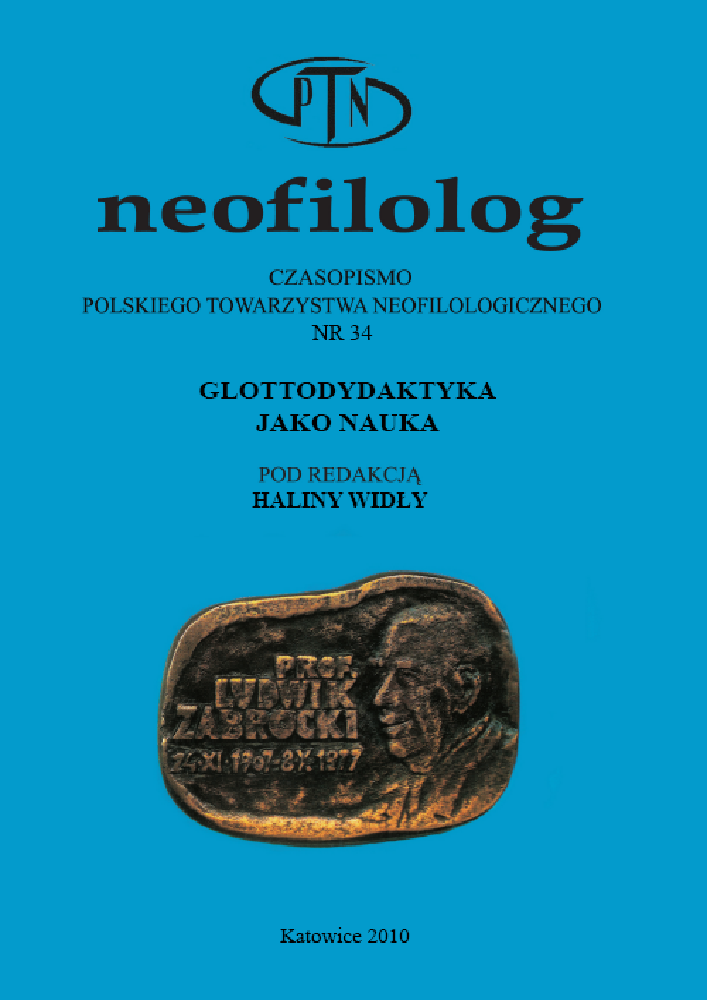Abstract
This paper aims to present an overview of the most typical methods and tools used in studies of young children learning foreign languages. Two major groups of potential subjects have been distinguished and characterized: children learning L2 from the age of (0) 1 till 3 and from the age of 3 till 6. In the studies in the first group methods similar to studies of L1 are suggested: longitudinal case studies using observation diaries, audio- video recordings, interviews with parents, and vocabulary checklists for cross-sectional research. In the studies of older children (3-6) elicitation of language data during testing sessions is possible and recommended, for which the tools most frequently used are: imitation of a speaker, carrying out orders and using picture prompts.
Literaturhinweise
Benett-Kastor, T. 1988. Analysing children’s language. Methods and theories. Oxford: Basil Blackwell.
Deuchar, M. i S. Quay. 2000. Bilingual acquisition. Oxford:OUP.
Dulay, H. i M. Burt. 1978. ‘Some remarks on creativity in language acquisition,’ (w) W.C. Ritchie (red.). Second Language Acquisition Research. Issues and Implications. New York: Academic Press.
Dunn, L.M. and D. M. Dunn. 2007.Peabody Picture Vocabulary Test (4 edycja). Form IIIA i IIIB. Minnesota: American Guidance Service.
Ellis, R. i R. Heimbach. 1997. ‘Bugs and birds: children’s acquisition of second language vocabulary through interaction.’ System 25: 247 – 259.
Fenson, L., P. Dale, J. Reznick et al. 1993.MacArthurCommunicative Development Inventories. User’s guide. San Diego: Singular Publishing.
Fenson, L., Dale, P., Reznick J. et al. 1994. ’Variability in early communicative Development.’ Monographs of the Society for Research in Child Development. Serial No. 242. Vol.59, No.5.
Gleason, J. B. i N.B.Ratner (red.). 2005. Psycholingwistyka. Sopot: Gdańskie Wydawnictwo Psychologiczne.
Huttenlocher et al.,1991. ‘Early vocabulary growth: relation to language input and gender.’ Developmental Psycholog y 27: 236 – 248.
Komorowska, H. 2005. Sprawdzanie umiejętności w nauce jęz yka obcego. Kontrola-Ocena – Testowanie. Warszawa: Fraszka Edukacyjna.
Leopold, W. 1939. Speech development of a bilingual child: a linguist’s record. Vol.I. Vocabulary growth in the first two years. Evanston, Ill.: Northwestern University Press.
Pearson, B. et al. 1998. ‘Assessing lexical development in bilingual babies and toddlers.’ The International Journal of Bilingualism’. 2: 347 – 372.
Reznick, J.S. and B.A. Goldfield. 1994. ‘Diary vs. representative checklist assessment of productive vocabulary.’ Journal of Child Language 21: 465 – 472.
Rokita, J. 2007. Lexical development in early L2 acquisition. Kraków: Wydawnictwo Naukowe Akademii Pedagogicznej.
Rokoszewska, K. 2006. ‘A study on the effectiveness of the Helen Doron method – research results.’ Acta Univeristatis Wratislaviensis 2892: 135 – 152.
Smoczyńska, M. 1999. Inwentarz Rozwoju Mowy i Komunikacji. Copyright materials.
Szuman, S. 1955. ‘ Rozwój treści słownika u dzieci.’ Studia Pedagogicane, 1955: 2. www.helendoron.com
Lizenz
Copyright (c) 1970 Joanna Rokita-Jaśkow

Dieses Werk steht unter der Lizenz Creative Commons Namensnennung - Keine Bearbeitungen 4.0 International.
Autoren:
Die Autoren der zur Veröffentlichung in der Zeitschrift Neofilolog angenommenen Texte sind verpflichtet, den Vertrag über die Erteilung einer kostenlosen Lizenz für die Werke mit der Verpflichtung zur Erteilung einer Sublizenz CC auszufüllen, zu unterzeichnen und an die Adresse der Redaktion zurückzusenden.
Gemäß Vertrag erteilen die Autoren auf die in der Zeitschrift Neofilolog veröffentlichten Texte der Adam-Mickiewicz-Universität in Poznań eine nicht exklusive und kostenlose Lizenz und erlauben die Verwendung der Sublizenz Creative Commons Attribution-NoDerivatives 4.0 International (CC BY-ND 4.0).
Die Autoren behalten das Recht zur weiteren freien Verfügung über das Werk.
Benutzer:
Interessierte Onlinebenutzer dürfen die seit 2017 veröffentlichten Werke unter folgenden Bedingungen nutzen:
- Anerkennung der Urheberschaft - die Verpflichtung, zusammen mit dem verbreiteten Werk Informationen über die Urheberschaft, den Titel, die Quelle (Links zum Originalwerk, DOI) und die Lizenz selbst bereitzustellen;
- ohne Schaffung abgeleiteter Werke - das Werk muss in seiner ursprünglichen Form erhalten bleiben, ohne Zustimmung des Autors dürfen keine Studien, beispielsweise Übersetzungen, verbreitet werden.
Die Urheberrechte aller veröffentlichen Texte sind vorbehalten.
Sonstige:
Die Adam-Mickiewicz-Universität in Poznań behält das Recht auf die Zeitschrift als Gesamtheit (Layout, Grafik, Titel, Umschlagsprojekt, Logo usw.).
